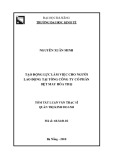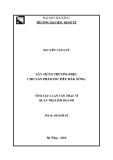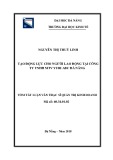
SEMILINEAR PROBLEMS WITH BOUNDED
NONLINEAR TERM
MARTIN SCHECHTER
Received 17 August 2004
We solve boundary value problems for elliptic semilinear equations in which no asymp-
totic behavior is prescribed for the nonlinear term.
1. Introduction
Many authors (beginning with Landesman and Lazer [1]) have studied resonance prob-
lems for semilinear elliptic partial differential equations of the form
−∆u−λu=f(x,u)inΩ,u=0on∂Ω, (1.1)
where Ωis a smooth bounded domain in Rn,λis an eigenvalue of the linear problem
−∆u=λu in Ω,u=0on∂Ω, (1.2)
and f(x,t) is a bounded Carath´
eodory function on Ω×Rsuch that
f(x,t)−→ f±(x)a.e.ast−→ ± ∞ .(1.3)
Sufficient conditions were given on the functions f±to guarantee the existence of a solu-
tion of (1.1). (Some of the references are listed in the bibliography. They mention other
authors as well.)
In the present paper, we consider the situation in which (1.3) does not hold. In fact,
we do not require any knowledge of the asymptotic behavior of f(x,t)as|t|→∞.Asan
example, we have the following.
Theorem 1.1. Assume that
sup
v∈E(λ)ΩF(x,v)dx < ∞, (1.4)
where E(λ)is the eigenspace of λand
F(x,t)=t
0f(x,s)ds. (1.5)
Copyright ©2005 Hindawi Publishing Corporation
Boundary Value Problems 2005:1 (2005) 1–8
DOI: 10.1155/BVP.2005.1

2 Semilinear problems with bounded nonlinear term
Assume also that if there is a sequence {uk}such that
Puk
−→ ∞ ,
I−Puk
≤C,
2ΩFx,ukdx −→ b0,
fx,uk−→ f(x)weakly in L2(Ω),
(1.6)
where f(x)⊥E(λ)and Pis the projection onto E(λ), then
b0≤f,u1−B0, (1.7)
where B0=ΩW0(x)dx,W0(x)=supt[(λ−1−λ)t2−2F(x,t)],andu1is the unique solu-
tion of
−∆u−λu=f,u⊥Eλ.(1.8)
Then (1.1) has at least one solution. In particular, the conclusion holds if there is no sequence
satisfying (1.6).
A similar result holds if (1.4)isreplacedby
inf
v∈E(λ)ΩF(x,v)dx > −∞.(1.9)
In proving these results we will make use of the following theorem [2].
Theorem 1.2. Let Nbe a closed subspace of a Hilbert space Hand let M=N⊥. Assume
that at least one of the subspaces M,Nis finite dimensional. Let Gbe a C1-functional on H
such that
m1:=inf
w∈Msup
v∈N
G(v+w)<∞,
m0:=sup
v∈N
inf
w∈MG(v+w)>−∞.(1.10)
Then there are a constant c∈Rand a sequence {uk}⊂Hsuch that
m0≤c≤m1,Guk−→ c,Guk−→ 0.(1.11)
2. The main theorem
We now state our basic result. Let Ωbe a domain in Rn,andletAbe a selfadjoint operator
on L2(Ω) such that the following hold.
(A)
σe(A)⊂(0,∞).(2.1)
(B) There is a function V(x)>0inL2(Ω) such that multiplication by Vis a compact
operator from D:=D(|A|1/2)toL1(Ω).
(C) If u∈N(A)\{0},thenu= 0a.e.inΩ.

Martin Schechter 3
Let f(x,t)beaCarath
´
eodory function on Ω×Rsatisfying
(D)
f(x,t)
≤V(x).(2.2)
Let λ(λ) be the largest (smallest) negative (positive) point in σ(A), and define
W0(x):=sup
tλt2−2F(x,t), (2.3)
W1(x):=sup
t2F(x,t)−λt2,(2.4)
where
F(x,t):
=t
0f(x,s)ds. (2.5)
Note that (D) implies
−V(x)2λ≤W0(x), W1(x)≤V(x)2
λ.(2.6)
We also assume
(E)
sup
v∈N(A)ΩF(x,v)dx < ∞.(2.7)
(F) If there is a sequence {uk}⊂Dsuch that
P0uk
−→ ∞ ,
I−P0uk
≤const,
2ΩFx,ukdx −→ b0,fx,uk−→ f(x) weakly in L2(Ω), (2.8)
where f(x)∈R(A)andP0is the projection of Donto N(A), then b0≤(f,u1)−B0,where
B0=ΩW0(x)dx and u1is the unique solution of
Au =f,u∈R(A).(2.9)
We have the following.
Theorem 2.1. Under hypotheses (A)–(F), there is at least one solution of
Au =f(x,u), u∈D. (2.10)
Proof. We b egin by letting
N=⊕
λ<0N(A−λ), N=N⊕N(A), M=N⊥∩D,M=M⊕N(A).(2.11)
By hypothesis (A), N,N(A), and Nare finite dimensional, and
D=M⊕N=M⊕N. (2.12)

4 Semilinear problems with bounded nonlinear term
It is easily verified that the functional
G(u):=(Au,u)−2ΩF(x,u)dx (2.13)
is continuously differentiable on D.Wetake
u2
D:=|A|u,u+
P0u
2(2.14)
as the norm squared on D.Wehave
G(u),v=2(Au,v)−2f(x,u), v,u,v∈D. (2.15)
Consequently (2.10)isequivalentto
G(u)=0, u∈D. (2.16)
Note that
(Av,v)≤λv2,v∈N, (2.17)
λw2≤(Aw,w), w∈M.(2.18)
By hypothesis (D), (2.5), and (2.13),
G(v)≤λv2+2V·v−→−∞ as v−→∞,v∈N.(2.19)
For w∈M,wewritew=y+w,y∈N(A), w∈M.Since|F(x,w)−F(x,y)|≤V(x)|w|
by (D) and (2.5), we have
G(w)≥λw2−2F(x,y)dx −2V·w.(2.20)
In view of (E), (2.19)and(2.20)imply
inf
MG>−∞,sup
N
G<∞.(2.21)
We can now apply Theorem 1.2 to conclude that there is a sequence satisfying (1.11). Let
uk=vk+wk+ρkyk,vk∈N,wk∈M,yk∈N(A),
yk
=1, ρk≥0.(2.22)
We claim that
uk
D≤C. (2.23)
To see this, note that (1.11)and(2.15)imply
Auk,h−fx,uk,h=oh.(2.24)

Martin Schechter 5
Taking h=vk,weseethatvk2=O(vk)inviewof(2.17) and (D). Thus vkDis
bounded. Similarly, taking h=wk,weseethatwkD≤C.Suppose
ρk−→ ∞ .(2.25)
There is a renamed subsequence such that yk→yin N(A). Clearly y=1. Thus by
hypothesis (D), y= 0 a.e. This means that ρkyk→∞.Hence(2.8)holds.Letu
k=vk+
wk∈N(A)⊥=R(A). Then u
kD≤C. Thus there is a renamed subsequence such that
u
k→u1weakly in D. By hypothesis (B), there is a renamed subsequence such that Vu
k→
Vu1strongly in L1(Ω). Since V(x)>0, there is another renamed subsequence such that
u
k→u1a.e. in Ω. On the other hand, since fk(x)=f(x,uk(x)) is uniformly bounded in
L2(Ω) by hypothesis (D), there is an f(x)∈L2(Ω)suchthatforasubsequence
fk(x)−→ f(x) weakly in L2(Ω).(2.26)
Since
Au
k,h−fk(x),h=ohD,h∈D, (2.27)
weseeinthelimitthatu1is a solution of (2.9), and consequently that f∈R(A). More-
over, we see by (2.27)that
Au
k−u1,h−fk−f,h=ohD,h∈D. (2.28)
Write u1=v1+w1, and take hsuccessively equal to vk−v1and wk−w1.Then
vk−v1
2
D≤2
Vvk−v1
1+o
v
k−v1
D,
wk−w1
2
D≤2
Vwk−w1
1+o
wk−w1
D.(2.29)
Hence u
k→u1in D. Consequently,
Auk,uk=Au
k,u
k=fk,u
k+o
u
k
−→ f,u1, (2.30)
2Fx,ukdx =Auk,uk−Guk−→ f,u1−c, (2.31)
where m0≤c≤m1.By(2.3)
G(v)≤(Av,v)−λv2+B0,v∈N.(2.32)
Thus m1≤B0. Consider first the case m1<B
0.Then(2.31) implies b0=(f,u1)−c,and
consequently, m0≤(f,u1)−b0≤m1<B
0.Thusb0>(f,u1)−B0,contradicting(1.7).
This shows that the assumption (2.25) is not possible. Consequently (2.23) holds, and we
have a renamed subsequence such that uk→ustrongly in Dand a.e. in Ω. It now follows
from (2.27)that
(Au,h)=f(x,u),h,h∈D, (2.33)










![Hình ảnh học bệnh não mạch máu nhỏ: Báo cáo [Năm]](https://cdn.tailieu.vn/images/document/thumbnail/2024/20240705/sanhobien01/135x160/1985290001.jpg)















